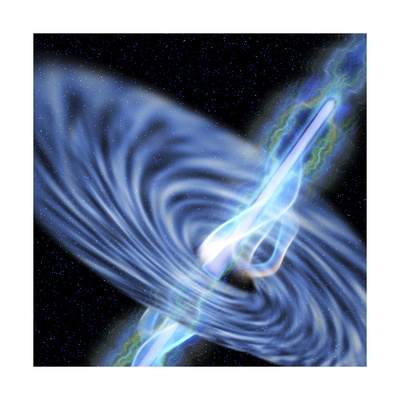In geocentric universe of Aristotle and Ptolemy, orbits of Moon, Sun and five planets (Mercury, Venus, Mars, Jupiter, Saturn) circle Earth:
Outermost text reads: celum empireum habitaculum dei et omnium electorum (heavenly empire, dwelling of God and all the selected).
"Figura dos Corpos Celestes"; Bartolomeu Velho, Principio da verdadeira cosmographia e geographia unniversal de todas as terras (Paris, 1568): Joaquim Alves Gaspar (Alvesgaspar), Public Domain, via Wikimedia Commons @ https://commons.wikimedia.org/wiki/File:Bartolomeu_Velho_1568.jpg
Collaboration between Stephen Hawking and Sir Roger Penrose (born 8 August 1931) has transformed modern understanding of the universe, especially of black holes.
black hole in front of Large Magellanic Cloud, with Cloud's image distorted by gravitational lensing, known as the Einstein Ring
simulation of black hole in front of Large Magellanic Cloud: Alain r, CC BY SA 2.5, via Wikimedia Commons @ https://commons.wikimedia.org/wiki/File:BH_LMC.png
Multiplicity of dimensions may baffle imaginations: Stephen Hawking easily conceives of 11 dimensions.
image of a two-dimensional hypersurface of the quintic Calabi-Yau three-fold: Jbourjai, Public Domain, via Wikimedia Commons @ https://commons.wikimedia.org/wiki/File:Calabi_yau.jpg
Stephen Hawking enjoys zero gravity during flight onboard Boeing 727 aircraft owned by Zero Gravity Corporation.
Peter Diamandis (right), Zero G Corp founder, and Byron Lichtenberg (left), formerly shuttle payload specialist, now Zero G Corp president, aerially rotate Stephen Hawking, while Stephen's aide Nicola O'Brien spells.
image credit Jim Campbell, Aero-News Network (NASA); for release on 04/26/2007: NASA Kennedy Media Archive, Public Domain, via Wikimedia Commons @ https://commons.wikimedia.org/wiki/File:Physicist_Stephen_Hawking_in_Zero_Gravity_NASA.jpg
Stephen Hawking enjoys zero gravity during flight onboard Boeing 727 aircraft owned by Zero Gravity Corporation.
Peter Diamandis (right), Zero G Corp founder, and Byron Lichtenberg (left), formerly shuttle payload specialist, now Zero G Corp president, aerially rotate Stephen Hawking, while Stephen's aide Nicola O'Brien spells.
image credit Jim Campbell, Aero-News Network; for release on 04/26/2007: NASA Kennedy Media Archive, Public Domain, via Wikimedia Commons @ https://commons.wikimedia.org/wiki/File:Physicist_Stephen_Hawking_in_Zero_Gravity_NASA.jpg
Black holes have beguiled such astrophysical geniuses as Albert Einstein and Stephen W. Hawking.
Visualization of Einstein's general theory of relativity: Simulation of three-dimensional merging black holes by crunching Einstein's theory into NASA supercomputer constitutes largest astrophysical calculation ever performed on NASA supercomputer.
Columbia supercomputer, NASA Ames Research Center, Mountain View, Santa Clara County, San Francisco Bay Area, Northern California: Christopher Henze/NASA, Public Domain, via Wikimedia Commons @ https://commons.wikimedia.org/wiki/File:This_visualization_shows_what_Einstein_envisioned.jpg; via NASA Goddard Space Flight Center @ https://www.nasa.gov/centers/goddard/universe/gwave.html















 Are Hawaiian Huakai Po Nightmarchers Avenging Halloween Thursday?on 10/02/2024
Are Hawaiian Huakai Po Nightmarchers Avenging Halloween Thursday?on 10/02/2024
 Mailing Addresses for 2023 Form 4868 Extending 1040 and 1040SR April 15, 2024, Due Dateon 04/15/2024
Mailing Addresses for 2023 Form 4868 Extending 1040 and 1040SR April 15, 2024, Due Dateon 04/15/2024
 Mailing Addresses for 2023 Forms 1040 and 1040SR Filed in 2024on 04/15/2024
Mailing Addresses for 2023 Forms 1040 and 1040SR Filed in 2024on 04/15/2024
 Mailing Addresses for 2022 Form 4868 Extending 1040 and 1040SR April 18, 2023, Due Dateon 04/13/2023
Mailing Addresses for 2022 Form 4868 Extending 1040 and 1040SR April 18, 2023, Due Dateon 04/13/2023



Comments
String theory invites introspection and investigation, particularly with some unusual configurations of our universe, doesn't it?
Dr. Hawking is one of my first two choices, tied for first place, for any astrophysics-illuminating publications even as Dr. Brian May, also of Queen, is the other ;-D.
Thank you, Hollie, for stopping by and visiting Dr. Stephen Hawking's legacy via this wizzley.
Me too, I find string theory a bit frustrating even as Dr. Hawking furnishes us fruitful ways to fight that personal and professional fulfillment not formed -- like him! -- by fluent astrophysics.
Isn't it impressive that Dr. Hawking is able to imagine at least 11 dimensions?
I love Stephen Hawking! I have often grappled with String Theory and been unable to quite get my head around it but Dr Hawking had a really easy writing style and was also excellent at interpreting complex scientific theory for the masses.
This book review is, since Wednesday, March 14, 2018, dedicated to the memory of Dr. Stephen Hawking (Jan. 8, 1942-Mar 14, 2018), with thanks for all the astrophysical truths that he manifested as simple truths for household-word-recognition understanding.
CruiseReady, All of Stephen Hawking's books are worth having on the shelves. He knows how to write for all levels of familiarity and non-familiarity. They generally average 150+ pages of comprehensible examples and understandable explanations by the world's most eminent astrophysicist on black holes, neutron stars, and quasars.
Hmmm ,,, Now, I am thinking that this book needs to be added to my library. Or more accurately, that my library needs to have this book added to it!
MBC, The book is definitely worth reading. Stephen Hawking's amiable personality comes through via his engaging style.
I saw the movie the Theory of Everything - it was fantastic! I'm sure the book is worth reading.
Mira, It's admirable that Stephen Hawking is willing to revise in favor of clarity and to correct errors in theory. I have read so many of his writings, and all of them are enlightening. I recommend this book!
I may read this book, too, even though apparently after writing this book he changed his views . . . again! :) Still, it would be interesting even as an exercise. It's amazing how we live on a tiny planet in this whole (mostly) unknown and poorly understood universe.